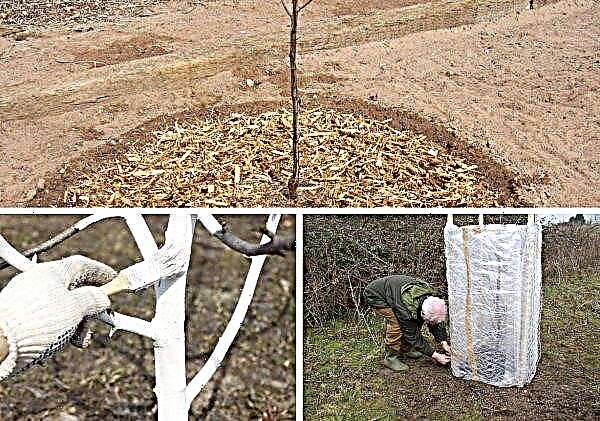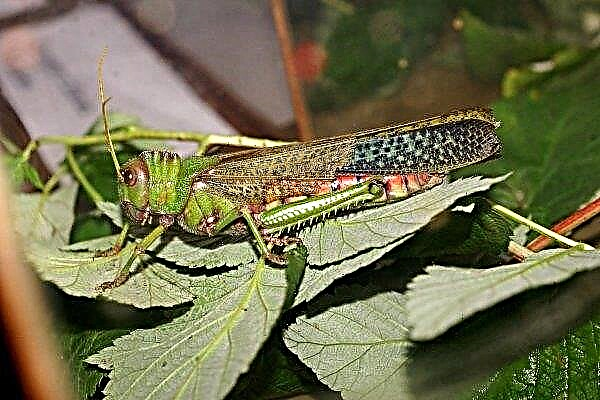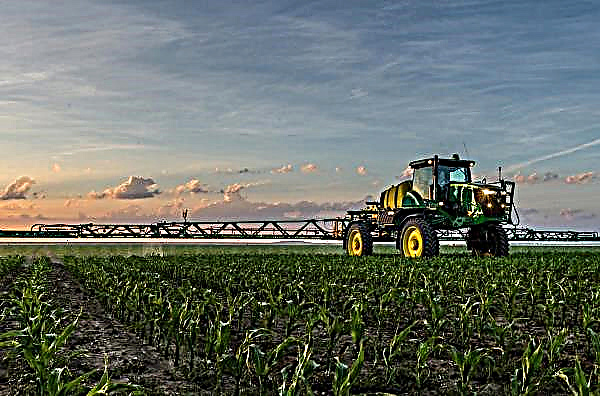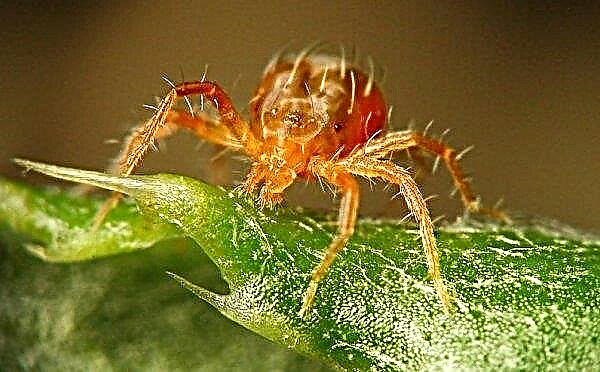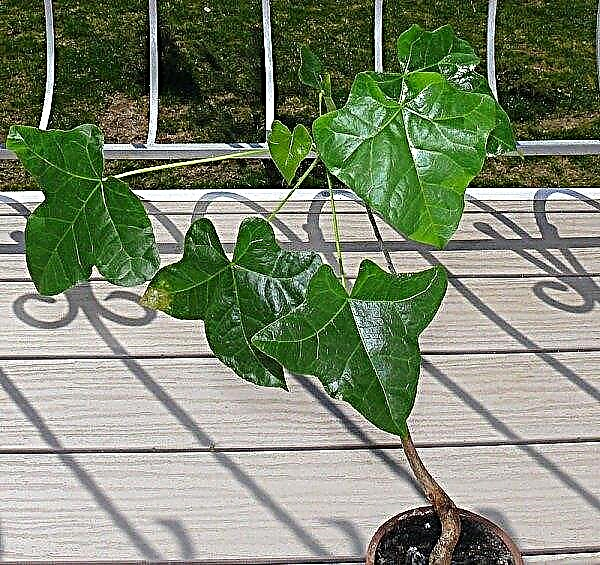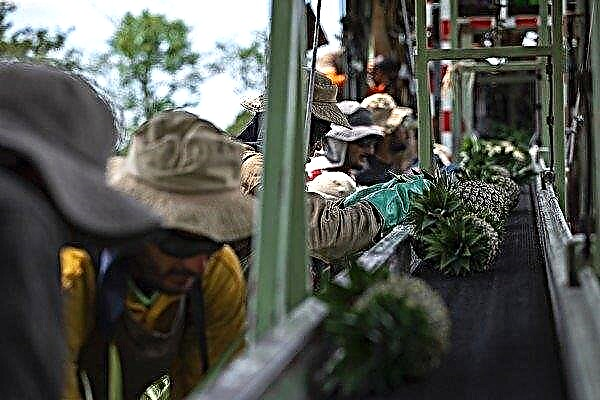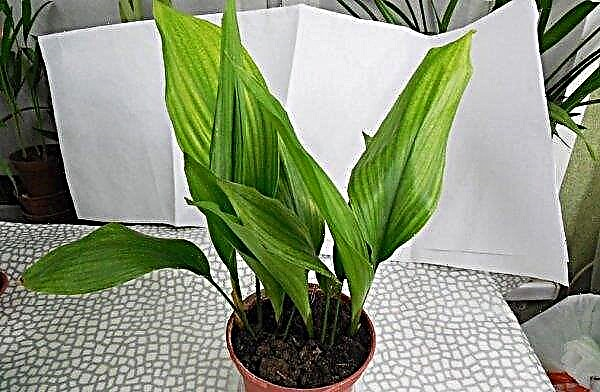Black beans are considered the most nutritious and healthy of all legumes. Read more about a valuable product and its cultivation later in the article.
View description
Among the varieties of the legume family, black grains are appreciated for the rich composition and dense structure of the pulp.
Did you know? The name "bean" culture was given by the ancient Greeks, comparing the pod with a narrow boat. In Greek, the boat sounds like a "fasheolus."
What does it look like?
Black bean is an annual, grows with a bush from 35 cm to 3 meters high, curly specimens are found. The plant has a developed root system, a flexible stem, large leaves with a sharp end in the shape of a heart. Beans ripen in bivalve pods that hang on stems. Depending on the variety, the number of grains varies from 3 to 8, the length of the pods is from 5 cm to 20 cm. The pods are not necessarily black in color, like grains. There are varieties with variegated color of the valves, with a yellow and pink tint.

Black bean varieties
The culture has varieties, among them there are asparagus species.
The most popular varieties among vegetable growers:
- The creeper - tall, more than 1 m bush, mid-early ripening. Noteworthy yellow pods with purple and pink spots. Grain weight - 0.6 g.

- Black Pearl - early, asparagus, grows in a compact bush up to 50 cm. Pods are saturated yellow in color, slightly curved up to 13 cm in length.

- Preto - One of the most popular varieties, a medium-sized bush. Beans are small 0.5 g, on a smooth surface there are white lines. When cooking, it acquires a sweet taste and berry aroma.
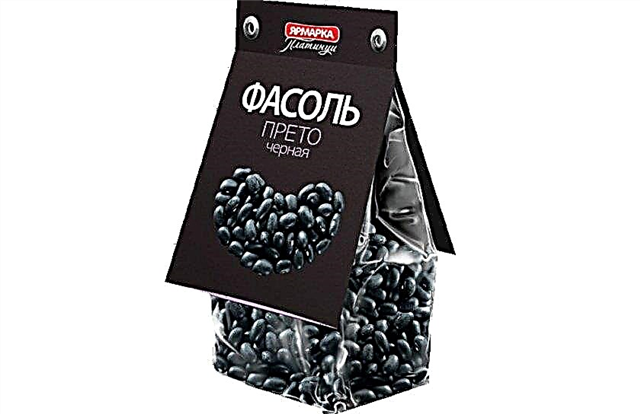
- Kidney - bush about 50 cm in height, large grains weighing 1.5 g and a reddish tint. During heat treatment, it smells of baked bread, the flesh with a certain grain size.
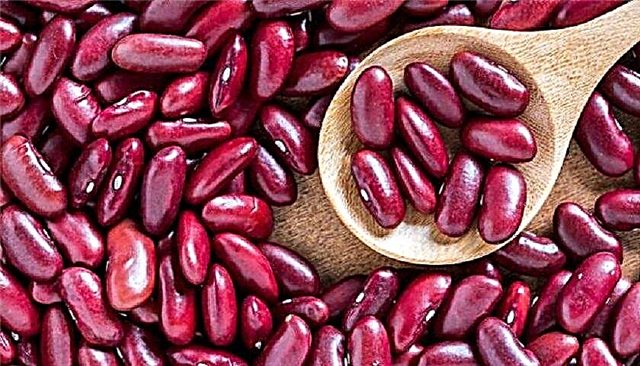
- Mauritanian - curly stems, up to 3 m long. Mid-season variety, pods 10-12 cm, grains weighing up to 3 g, silver streaks are mixed with the main color of the fruit.

Composition and nutritional value
Black beans contain vitamins, micro-, macrocells, such as omega-3 and omega-6 fatty acids, amino acids, flavonoids.
One hundred grams of beans satisfy the daily requirement of the body for folic acid, the amount of vitamin B9 is 111% of the norm.
Other vitamins (in% of the daily intake of 100 g):
- B1 (thiamine) - 60;
- B2 (riboflavin) - 10.7;
- B4 (choline) - 13.3;
- B5 (pantothenic acid) - 18;
- B6 (pyridoxine) - 14.3;
- E (tocopherol) - 1.4;
- K (phylloquinone) - 4.7;
- PP, NE (niacin, nicotinamide) —9.8.
- potassium - 59.3;
- calcium — 12.3;
- magnesium —42.8;
- sodium - 0.4;
- phosphorus —44;
- iron —27.9;
- Manganese - 53;
- copper - 84.1;
- selenium - 5.8;
- zinc - 30.4.
The calorie content of raw ripe beans is 341 kcal / 100 g of product.
The nutritional value:
- proteins - 21.6 g;
- fats - 1.4 g;
- carbohydrates - 62.4 g;
- fiber - 15.5 g;
- water - 11.02 g;
- ash 3.6 g.

What is the use of black beans?
Due to its rich composition, black grains are useful for the body, participate in many vital processes.
Product use has the following effects:
- improves mental activity;
- calms the nervous system;
- strengthens the immune system;
- supports the work of the heart muscle;
- stimulates the production of hemoglobin;
- helps in digestion;
- improves kidney and liver function.
For men
Thanks to proteins that are as close as possible to animal proteins, the product allows you to quickly replenish the energy reserve, build muscle. Beans are involved in the function of hematopoiesis, increasing blood flow, including in the pelvic organs. This in turn increases sexual desire, stimulates the production of sperm. Black grains with regular use reduce the risk of prostate adenoma.

For women
A large number of vitamins will help women maintain the beauty, purity and youthfulness of the skin. The beneficial substances obtained with the product will strengthen the hair and nails. A positive effect on the nervous system, normalization of sleep, which has a beneficial effect on appearance. The presence of iron and amino acids will help to transfer painful critical days more easily and recover faster after them. Beans included in the diet on a regular basis will serve as a prevention of malignant tumors of female organs.
During pregnancy and lactation
Black beans during pregnancy replenish iron and copper, which reduces the risk of anemia, improves kidney function, and reduces swelling. The product has a beneficial effect on the regeneration processes in the skin cells, stimulates the production of melanin, which prevents the formation of age spots. The balance of minerals and amino acids helps to cope with the symptoms of toxicosis. In addition, in the postpartum period, bean dishes normalize the hormonal background, restore strength.
Young beans and its asparagus varieties are most useful for a nursing mother. The product will saturate milk with nutrients, strengthening the body of both the mother and the baby. Moderate consumption of black grains will increase the amount of milk.

For the digestive tract
Thiamine and pantothenic acid are participants in protein, carbohydrate metabolism. Fiber cleanses the intestines from harmful accumulations, normalizes the acidity of gastric juice. Useful elements in the composition of the product improve the condition of the gastric mucosa, improve digestion. Despite the high protein content, amino acids in the composition accelerate the process of its breakdown, facilitating the work of the intestine.
With diets and losing weight
If you want to lose weight, a boiled or stewed product is recommended: during heat treatment, the calorie content of legumes is reduced by a factor of three. A portion in 100 g of boiled grains without salt contains only 132 kcal. Improved metabolism, thanks to active enzymes, does not allow long carbohydrates to be absorbed completely, which reduces the number of fat cells. Fiber “sweeps out” toxins from the digestive organs, which also contributes to weight loss.
In therapeutic diets, the product is recommended in order to recover from serious illnesses or previous surgery. Useful elements in the composition accelerate the regeneration processes, saturate with vitamins and minerals, strengthen the immune system.
With diabetes
The amino acid arginine in the composition of beans, takes part in the metabolic processes of the body, such as:
- blood urea synthesis;
- insulin production;
- lower cholesterol;
- lipid breakdown.
Video: Black Bean Properties
Harm and contraindications of black bean
A side effect of eating can be bloating. It is undesirable for elderly people to often use the product, because their digestive system no longer contains such active enzymes for the breakdown of heavy dietary fiber. It is undesirable to give a dish of legumes to young children: their enzymatic system is not yet fully formed.
- You can not use the product to people during the period of exacerbation:
- gastritis;
- stomach ulcers;
- pancreatitis
- colitis.
Features of growing black beans
The culture is demanding on the conditions, so to get a crop, you need to follow the rules for caring for it.
Selection and preparation of a landing site
The site should be illuminated and protected from the wind, the location of groundwater is at least 1.5 m. In autumn, the bed is dug up to the depth of the shovel bayonet, introducing humus or compost 6 kg / m², adding 30 g of phosphates and potassium salt to it.
Fresh, not overripe organics are detrimental to legumes; there is too much nitrogen in it.
Important! Heavy fiber will force the stomach to intensively produce juice to digest food, and this will provoke an increase in acidity and exacerbate the disease.
Seed preparation and sowing
Before sowing, the seeds are washed with a light pink solution of potassium permanganate, then washed and soaked in a biostimulator ("Kornevin") for 3 hours.
Depending on the climate in the region, sowing is carried out at the end of April or May. Sowing is carried out in furrows to a depth of 4-6 cm, 3-4 seeds are placed in one recess.
The distance between seeds and rows depends on the variety:
- bush - between seeds 40 cm, between rows 20 cm;
- curly - between seeds 55 cm, between rows 30 cm.

Plant care
Watering should be moderate so as not to provoke root rot. The frequency of watering depends on the drying rate of the upper (15 cm) soil layer.
Apply sprinkling procedure:
- every 2-3 days during the heat and lack of precipitation;
- every 5 days with regular rains.
Mulching will help to control weed growth and protect crops from overheating, moisture evaporation. Peat and straw are used as mulch.
The first fertilizer is carried out a month after the emergence of seedlings. The plant is fed a mixture of urea and superphosphate in 10 g / 10 l of water. The second feeding is carried out after 3 weeks. Apply strained infusion of herbs diluted with water 1: 8. For the third time, wood ash 200 g / m² is applied to the soil.Important! For climbing varieties you need to install a trellis with several horizontal jumpers.
Growing beans in a greenhouse
Growing in greenhouse conditions is no different from caring for beans in open ground. Sowing is carried out earlier: in February, March. The greenhouse needs to be often ventilated, and the amount of water when watering should be reduced. High humidity can cause illness.
During a short daylight, the culture needs to provide additional lighting, otherwise it will begin to stretch.
Pests and diseases
Black beans do not attract pests, with the exception of slugs and scale insects. You can protect yourself from shields by planting repellents between rows (tansy, calendula, wormwood). The crushed walnut shell is scattered against the slugs.
When attacking pests, the following drugs are used according to the instructions:
- Aktara - from scale insects;
- Slug Eater - against slugs.
Collection and storage
Harvested in summer or autumn (late varieties). The mature pod makes a dry click when pressed.
Asparagus varieties for winter storage can be frozen, whole or chopped. Pods of grain varieties peel, leave to dry and ventilate. Store in glass jars at temperatures from + 5 ° C to + 15 ° C.
The use of black beans
Black beans, in addition to culinary purposes, are used as folk remedies, as an ingredient for the preparation of cosmetic masks.
In traditional medicine: preparation of infusions and decoctions
Folk methods of treatment use beans in decoctions and infusions.
Means help get rid of such conditions:
- diabetes;
- low acidity;
- stones in the urinary organs;
- skin inflammations (lotions);
- respiratory system diseases.
- The pods are crushed into powder, poured with boiling water 50 g / 400 ml, insist 12 hours. Take 100 ml before meals (3 times a day) from the formation of stones, gastrointestinal problems.
- The pods, crushed into powder and filled with cold water 50 g / 1l, insist 10 hours, filter. Consume 200 ml / 1 liter of water 1 time per day from respiratory problems.
- Powder from the pods of 20 g pour 200 ml of boiling water and boil in a water bath for 20 minutes. After which the broth should be filtered and taken 1 tbsp. l 3 times a day (before or after meals) to lower blood sugar.
- One kilogram of dry pods should be boiled in 3 liters of water. They drink the broth on an empty stomach, it improves the function of blood formation, improves digestion processes.
In cosmetology
Boiled bean pulp is the main ingredient in anti-aging and bleaching masks. In addition to removing pigment spots and freckles, the product restores the facial contour, tightens the skin. Masks have anti-inflammatory, moisturizing and nourishing effects. Apply to the skin of the face, neck, décolleté, hands.

In cooking. Recipes
Black beans are used in the preparation of many dishes.
Grains are used as:
- ingredient of soups;
- filling for baking and pancakes;
- component of vegetable stews and pastes;
- basis for warm salads;
- as an independent side dish.
Did you know? Guatemala has an unusual dessert: black bean beans in a chocolate shell.
Black Bean Recipes:
«Hummus". Boiled beans are mashed in a blender or a meat grinder. Use as a paste for sandwiches.
Mashed potatoes are also used in the preparation of Mexican snacks:
- Spread paste on thin pita bread.
- Add tomato rings, julienne sweet pepper.
- Sprinkled with canned corn and grated cheese, rolled into a roll.
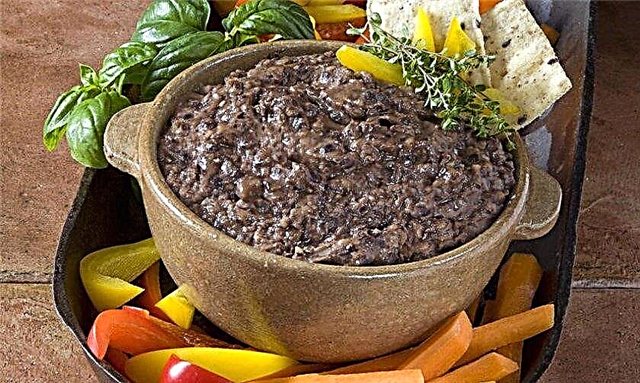
Bean Soup. As a basis, 200 ml of meat or vegetable broth is used.
Cooking:
- 100 g of beans are boiled in salted water. The water is then drained: it is not needed.
- In a pan with a double bottom, stew a straw chopped onion and 1 bell pepper for 5 minutes.
- Add 5 g of dry paprika, 100 g of buckwheat and stew for another 5 minutes.
- Next, beans, grated carrots and canned corn are put in the mixture, left to stew for 3 minutes.
- After they add 400 ml of cold water, add a bay leaf and let the soup boil.
- When serving, you can add a spoonful of natural yogurt.

Further sequence of actions:
- Bell pepper in half green, yellow and red fruit is cut into strips.
- One medium-sized tomato is diced.
- Greens - celery and parsley are chopped.
- All ingredients, including beans, are mixed and seasoned with olive oil.











